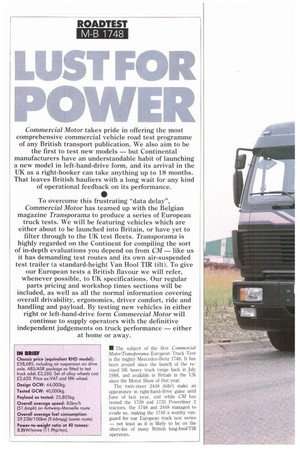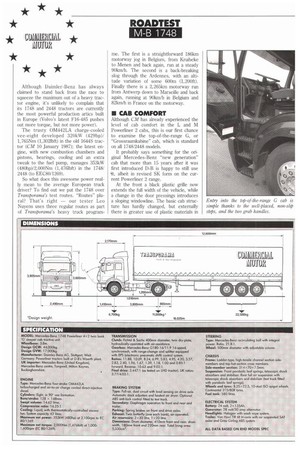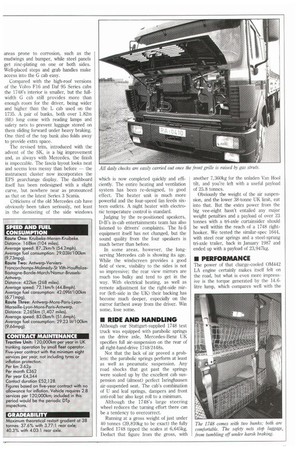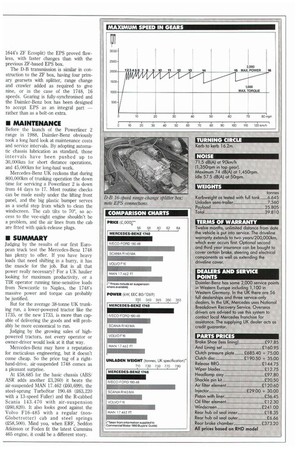LUST FOR
Page 30

Page 32

Page 33

Page 34

Page 35

If you've noticed an error in this article please click here to report it so we can fix it.
POWER
Commercial Motor takes pride in offering the most comprehensive commercial vehicle road test programme of any British transport publication. We also aim to be the first to test new models — but Continental manufacturers have an understandable habit of launching a new model in left-hand-drive form, and its arrival in the UK as a right-hooker can take anything up to 18 months. That leaves British hauliers with a long wait for any kind of operational feedback on its performance.
To overcome this frustrating "data delay", Commercial Motor has teamed up with the Belgian magazine Transporama to produce a series of European truck tests. We will be featuring vehicles which are either about to be launched into Britain, or have yet to filter through to the UK test fleets. Transporama is highly regarded on the Continent for compiling the sort of in-depth evaluations you depend on from CM — like us it has demanding test routes and its own air-suspended test trailer (a standard-height Van Hool TIR tilt). To give our European tests a British flavour we will refer, whenever possible, to UK specifications. Our regular parts pricing and workshop times sections will be included, as well as all the normal information covering overall drivability, ergonomics, driver comfort, ride and handling and payload. By testing new vehicles in either right or left-hand-drive form Commercial Motor will continue to supply operators with the definitive independent judgements on truck performance — either at home or away.
• The subject of the first Commercial MotorlTransporama European Truck Test is the mighty Mercedes-Benz 1748. It has been around since the launch of the revised SK heavy truck range back in July 1988, and available in Britain in the UK since the Motor Show of that year.
The twin-steer 2448 didn't make an appearance in right-hand-drive guise until June of last year, and while CM has tested the 1729 and 1735 Powerliner 2 tractors, the 1748 and 2448 managed to evade us, making the 1748 a worthy vanguard for our European truck test series — not least as it is likely to be on the short-list of many British long-haul/TIR operators.
Although Daimler-Benz has always claimed to stand back from the race to squeeze the maximum out of a heavy trac-. tor engine, it's unlikely to complain that its 1748 and 2448 tractors are currently the most powerful production artics built in Europe (Volvo's latest F16-485 pushes out more torque, but not more power).
The trusty 0M442LA charge-cooled vee-eight developed 320kW (429hp)/ 1,765Nm (1,3021b1t) in the old 1644S tractor (CM 10 January 1987); the latest engine, with new combustion chambers and pistons, bearings, cooling and an extra tweak to the fuel pump, manages 353kW (480hp)/2,000Nm (1,4761bft) in the 1748/ 2448 (to EEC80/1269).
So what does this awesome power really mean to the average European truck driver? To find out we put the 1748 over Transporama's test routes. "Routes" plural? That's right — our tester Leo Nuyens uses three regular routes as part of Transporama's heavy truck program me. The first is a straightforward 186km motorway jog in Belgium, from Kruibeke to Menen and back again, run at a steady 90km/h. The second is a back-breaking slog through the Ardennes, with an altitude variation of some 600m (1,20010. Finally there is a 2,265km motorway run from Antwerp down to Marseille and back again, running at 90km/h in Belgium and 82km/h in France on the motorway.
• CAB COMFORT
Although CM has already experienced the level of cab comfort in the L and M Powerliner 2 cabs, this is our first chance to examine the top-of-the-range G, or "Grossraumkabine" cab, which is standard on all 1748/2448 models.
It probably says something for the original Mercedes-Benz "new generation" cab that more than 15 years after it was first introduced D-B is happy to still use it, albeit in revised SK form on the current Powerliner 2 range.
At the front a black plastic grille now extends the full width of the vehicle, while a change in the door pressings introduces a sloping windowline. The basic cab structure has hardly changed, but externally there is greater use of plastic materials in areas prone to corrosion, such as the mudwings and bumper, while steel panels get zinc-plating on one or both sides. Well-placed steps and grab handles make access into the G cab easy.
Compared with the high-roof versions of the Volvo F16 and Daf 95 Series cabs the 1748's interior is smaller, but the fullwidth G cab still provides more than enough room for the driver, being wider and higher than the L cab used on the 1735. A pair of bunks, both over 1.82m (6ft) long come with reading lamps and safety nets to prevent luggage stored on them sliding forward under heavy braking. One third of the top bunk also folds away to provide extra space.
The revised trim, introduced with the advent of the SK, is a big improvement and, as always with Mercedes, the finish is impeccable. The fascia layout looks neat and seems less messy than before — the instrument cluster now incorporates the EPS gearchange display. The dashboard itself has been redesigned with a slight curve, but nowhere near as pronounced as that on the latest Series 3 Scania.
Criticisms of the old Mercedes cab have obviously been taken seriously, not least in the demisting of the side windows which is now completed quickly and efficiently. The entire heating and ventilation system has been re-designed, to good effect. The heater unit is much more powerful and the four-speed fan feeds sixteen outlets. A night heater with electronic temperature control is standard.
Judging by the re-positioned speakers, D-B's in-cab entertainments team has also listened to drivers' complaints. The hi-fl equipment itself has not changed, but the sound quality from the four speakers is much better than before.
In some areas, however, the longserving Mercedes cab is showing its age. While the windscreen provides a good field of view, visibility to the sides is not so impressive; the rear view mirrors are much too bulky and tend to get in the way. With electrical heating, as well as remote adjustment for the right-side mirror (left-side in the UK) their backing has become much deeper, especially on the mirror furthest away from the driver. Win some, lose some.
• RIDE AND HANDLING
Although our Stuttgart-supplied 1748 test truck was equipped with parabolic springs on the drive axle, Mercedes-Benz UK specifies full air-suspension on the rear of all right-hand-drive 1748/2448s.
Not that the lack of air proved a problem: the parabolic springs perform at least as well as pneumatic suspension. Any road shocks that got past the springs were soaked up by the excellent cab suspension and (almost) perfect Isringhausen air-suspended seat. The cab's combination of U and leaf springs, dampers and front anti-roll bar also kept roll to a minimum.
Although the 1748's large steering wheel reduces the turning effort there can be a tendency to overcorrect.
Running at a gross weight of just under 40 tonnes (39,810kg to be exact) the fully fuelled 1748 tipped the scales at 6,645kg. Deduct that figure from the gross, with another 7,360kg for the unladen Van Hool tilt, and you're left with a useful payload of 25.8 tonnes.
Obviously the weight of the air suspension, and the lower 38-tonne UK limit, eat into that. But the extra power from the big vee-eight hasn't entailed any major weight penalties and a payload of over 23 tonnes with a tri-axle curtainsider should be well within the reach of a 1748 righthooker. We tested the similar-spec 1644, with steel rear springs and a steel-sprung tri-axle trailer, back in January 1987 and ended up with a payload of 23,947kg.
• PERFORMANCE
The power of that charge-cooled 0M442 LA engine certainly makes itself felt on the road, but what is even more impressive is the torque generated by the 14.6litre lump, which compares well with the
likes of the Iveco TurboStar 190.48, MAN 17.462, Volvo F16-485 and Scania 143.470. Its 2,000Nm, produced between 1,000-1,600rpm, allows for a very flexible driving style; even when pulling back up from 900rpm there is plenty of power in hand.
• DRIVEABILITY
The 1748's driveability is, not surprisingly, superior to its predecessor. For starters it is considerably faster than the 1644. Except when maintaining way on motorway inclines, or on tough hills, the splits in the 16-speed EPS-controlled gearbox can invariably be missed out without compromising the 17.48's staggering performance. For the quickest and smoothest progress from rest, however, a 2H/4H/6L pattern in the lower gears seems to work best.
Once the 1748 is underway its lazy power is clearly apparent. It's certainly smoother than either the naturallyaspirated or turbocharged SK tractors, though perhaps not quite as smooth as the vee-10 powered MAN 19.462 (CM 1-7 September 1988).
Despite the lower continental motorway speed limits, the left-hand-drive 1748 is available with a numerically lower (faster) back axle ratio than the UK model (3.447:1 against the UK 3.77:1 standard and optional 4.03:1 ratio). This obviously helps keep engine revs down at motorway speeds. We understand, however, that the left-hooker's faster axle is likely to find its way into the UK before too long.
Both the UK ratios provided a maximum geared speed of 111.8km/h, but maximum gradeability at 38 tonnes GCW varies from 37.6% with the standard ratio to 40.3% with the latter. With that kind of geared speed, it's not surprising that Daimler-Benz fits a speed limiter as standard to all 1748/2448 tractors.
Such is the power on the 1748 that it would have been very easy to spin the drive-axle wheels on a wet road, had our test truck not been fitted with the optional Acceleration Skid Control system (ASR).
This prevents wheel-spin by either applying the brakes in much the same way as the normal anti-lock ABS system, or by easing back on the fuel pump until traction is regained.
A warning light in the cab indicates when it is operating, and judging by our experience such a device is a real benefit on such a powerful truck. Another essential feature with this kind of power is a top class service brake system. In this department the 1748 is well up to par, although the exhaust brake proved less than impressive.
• FUEL ECONOMY
Top gear (eight high) on the 1748's 16speed splitter box is an 0.85:1 overdrive which should help keep fuel costs down. At a constant 90knn/b (56mph), the 1748 only used an average of 29.031it/100km (9.73mpg) on the motorway run.
On the tough Ardennes hill section it really showed its mettle, returning 42.091ft/100km (6.71mpg) at a very high average speed of 72.1Iun/h.
Over the long-distance trek from Antwerp to Marseille and back the 1748 averaged 29.231t/100km (9.66mpg). Until we have built up our data bank of "euro tests" we can only view the 1748's figures in isolation. Nevertheless, few operators are likely to complain about those motorway figures, although they are obviously based on lower Continental speed limits.
For the record, the overall average fuel consumption figure recorded by the righthand-drive 1735 Mercedes (CM 10 August 1989), running at UK speed limits, was a respectable 39. 51it/100km (7.16mpg), with motorway consumption reaching 34.91it/1001un (8.1mpg).
Our 1748's coupling height of 1,200mm helped keep the combination's overall height to 3,905mm, although the fairly large gap between the tractor and trailer of 930m no doubt had its effect on fuel economy. This is the result of using a conventional trailer with a 3.8m-wheelbase tractive unit.
• TRANSMISSION
In the past we have had our reservations about D-B's electro-pneumatic gear shifting system EPS. Our view has been that while any delay in shift change is not a problem with a high-powered tractor, on the lower-powered 1729 tested in October 1988 it could be caught out when downshifting on severe gradients.
On the 1748, however, now fitted with a Daimler-Benz gearbox (in place of the 1644's ZF Ecosplit) the EPS proved flawless, with faster changes than with the previous ZF-based EPS box.
The D-B transmission is similar in construction to the ZF box, having four primary gearsets with splitter, range change and crawler added as required to give nine, or in the case of the 1748, 16 speeds. Gearing is fully-synchronised and the Daimler-Benz box has been designed to accept EPS as an integral part rather than as a bolt-on extra.
• MAINTENANCE
Before the launch of the Powerliner 2 range in 1988, Daimler-Benz obviously took a long hard look at maintenance costs and service intervals. By adopting automatic chassis lubrication as standard, those intervals have been pushed up to 30,000Iun for short distance operations, and 45,0001un for long-haul work.
Mercedes-Benz UK reckons that during 800,000km of trunking operation the down time for servicing a Powerliner 2 is down from 44 days to 17. Most routine checks can be made easily under the lifting front panel, and the big plastic bumper serves as a useful step from which to clean the windscreen. The cab tilts to 70°, so access to the vee-eight engine shouldn't be a problem, and the air Lines from the cab are fitted with quick-release plugs.
• SUMMARY
Judging by the results of our first European truck test the Mercedes-Benz 1748 has plenty to offer. If you have heavy loads that need shifting in a hurry, it has the muscle for the job. But is all that power really necessary? For a UK haulier looking for maximum productivity, or a TIR operator running time-sensitive loads from Newcastle to Naples, the 1748's massive power and torque can probably be justified.
But for the average 38-tonne UK trunking run, a lower-powered tractor like the 1735, or the new 1733, is more than capable of delivering the goods and will probably be more economical to run.
Judging by the growing sales of highpowered tractors, not every operator or owner-driver would look at it that way.
Mercedes-Benz may have a reputation for meticulous engineering, but it doesn't come cheap. So the price tag of a righthand-drive, air-suspended 1748 comes as a pleasant surprise.
At R58,685 for the basic chassis (ABS/ ASR adds another £3,260) it beats the air-suspended MAN 17.462 (£60,699), the steel-sprung TurboStar 190A8 (£63,220 with a 13-speed Fuller) and the R-cabbed Scania 143.470 with air-suspension (60,820). It also looks good against the Volvo F16-485 with a regular (nonGlobetrotter) cab and steel springs (258,500). Mind you, when ERF, Seddon Atkinson or Foden fit the latest Cummins 465 engine, it could be a different story.




































































































































